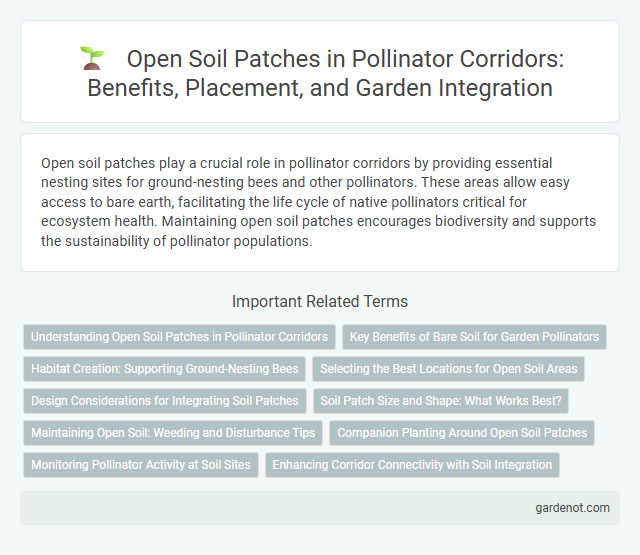Open soil patches play a crucial role in pollinator corridors by providing essential nesting sites for ground-nesting bees and other pollinators. These areas allow easy access to bare earth, facilitating the life cycle of native pollinators critical for ecosystem health. Maintaining open soil patches encourages biodiversity and supports the sustainability of pollinator populations.
Understanding Open Soil Patches in Pollinator Corridors
Open soil patches in pollinator corridors serve as essential nesting grounds for solitary bees and ground-nesting insects, providing them with safe habitats for reproduction. These bare soil areas facilitate access to moisture and warmth, which are critical for larval development and adult activity. Maintaining and creating diverse open soil patches enhances pollinator biodiversity and supports ecosystem resilience.
Key Benefits of Bare Soil for Garden Pollinators
Bare soil patches provide essential nesting sites for solitary bees, allowing them to dig burrows and lay eggs safely. These exposed areas also facilitate thermoregulation, helping pollinators maintain optimal body temperature for activity. Maintaining open soil increases diversity and abundance of native pollinators critical for a healthy garden ecosystem.
Habitat Creation: Supporting Ground-Nesting Bees
Open soil patches serve as vital habitats for ground-nesting bees by providing bare, loose soil essential for nesting and reproduction. These exposed areas within pollinator corridors enhance biodiversity by supporting native bee populations crucial for pollination services in both urban and rural ecosystems. Maintaining and creating open soil zones directly contributes to sustainable pollinator conservation efforts and agricultural productivity.
Selecting the Best Locations for Open Soil Areas
Selecting the best locations for open soil patches within pollinator corridors involves prioritizing areas with minimal human disturbance and ample sunlight exposure, which are crucial for ground-nesting pollinators like solitary bees. Soil texture and moisture levels must be assessed to ensure suitability for burrowing species, with sandy or loamy soils being optimal for nest excavation. Incorporating these open soil areas strategically enhances habitat diversity, improving pollinator health and promoting ecosystem resilience.
Design Considerations for Integrating Soil Patches
Open soil patches in pollinator corridors require careful design considerations to enhance habitat suitability and biodiversity. Incorporating loose, well-drained soil with minimal compaction supports nesting and foraging activities of ground-nesting bees and other pollinators. Strategic placement near diverse flowering plants increases resource availability and encourages effective pollinator movement across the corridor.
Soil Patch Size and Shape: What Works Best?
Optimal soil patch size for pollinator corridors typically ranges from 1 to 5 square meters, providing sufficient foraging resources without overwhelming local flora diversity. Irregularly shaped soil patches with edge complexity promote higher pollinator activity by increasing habitat variety and nesting sites. Maintaining connectivity between patches enhances pollinator movement and supports biodiversity within the corridor ecosystem.
Maintaining Open Soil: Weeding and Disturbance Tips
Maintaining open soil patches within a pollinator corridor is essential for ground-nesting bees and other beneficial insects that require bare or sparsely vegetated areas for habitat. Regular weeding prevents invasive plant species from overtaking these patches, ensuring soil remains exposed and suitable for nesting. Controlled disturbance, such as light tilling or scraping, helps maintain soil texture and microhabitats necessary to support diverse pollinator populations.
Companion Planting Around Open Soil Patches
Open soil patches provide essential nesting habitats for solitary pollinators, enhancing biodiversity within pollinator corridors. Companion planting with native wildflowers and herbs like lavender, borage, and coneflower around these patches attracts bees and butterflies, boosting pollination efficiency. Strategically integrating diverse plant species promotes continuous bloom cycles, supporting pollinator health and ecosystem resilience.
Monitoring Pollinator Activity at Soil Sites
Open soil patches within pollinator corridors serve as essential habitats for ground-nesting bees, requiring continuous monitoring of pollinator activity to assess species diversity and nesting success. Employing techniques such as visual surveys, pan traps, and soil disturbance assessments provides critical data on pollinator behavior and population health at these sites. Maintaining detailed records of temporal and spatial activity patterns supports adaptive management strategies that enhance pollinator habitat quality and connectivity.
Enhancing Corridor Connectivity with Soil Integration
Open soil patches serve as critical elements in enhancing pollinator corridor connectivity by providing essential nesting habitats for ground-nesting bees and other pollinators. Integrating these soil patches strategically within green corridors increases habitat continuity, promoting movement and gene flow among pollinator populations. Soil texture, moisture levels, and exposure are optimized to support diverse pollinator species, boosting biodiversity and ecosystem resilience.
Open soil patch Infographic

 gardenot.com
gardenot.com